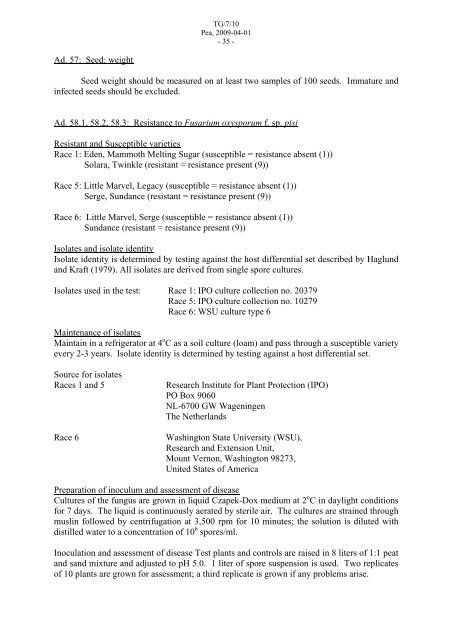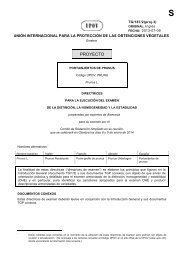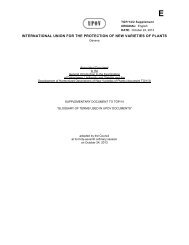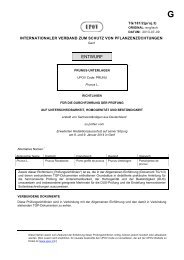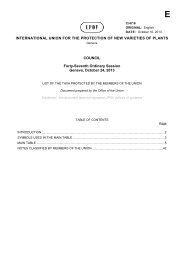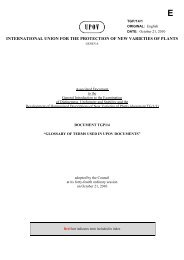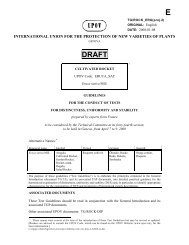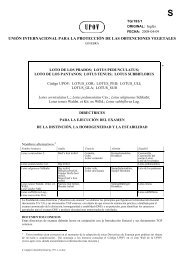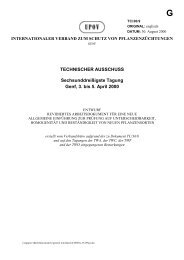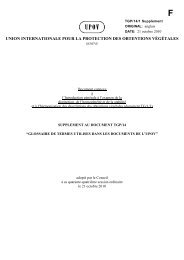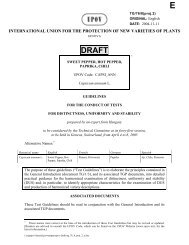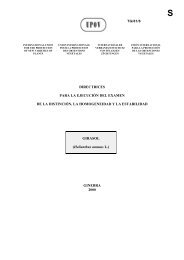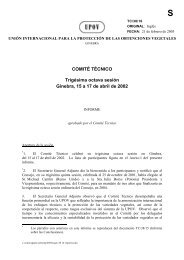Pisum sativum L. - International Union for the Protection of New ...
Pisum sativum L. - International Union for the Protection of New ...
Pisum sativum L. - International Union for the Protection of New ...
You also want an ePaper? Increase the reach of your titles
YUMPU automatically turns print PDFs into web optimized ePapers that Google loves.
Ad. 57: Seed: weight<br />
TG/7/10<br />
Pea, 2009-04-01<br />
- 35 -<br />
Seed weight should be measured on at least two samples <strong>of</strong> 100 seeds. Immature and<br />
infected seeds should be excluded.<br />
Ad. 58.1, 58.2, 58.3: Resistance to Fusarium oxysporum f. sp. pisi<br />
Resistant and Susceptible varieties<br />
Race 1: Eden, Mammoth Melting Sugar (susceptible = resistance absent (1))<br />
Solara, Twinkle (resistant = resistance present (9))<br />
Race 5: Little Marvel, Legacy (susceptible = resistance absent (1))<br />
Serge, Sundance (resistant = resistance present (9))<br />
Race 6: Little Marvel, Serge (susceptible = resistance absent (1))<br />
Sundance (resistant = resistance present (9))<br />
Isolates and isolate identity<br />
Isolate identity is determined by testing against <strong>the</strong> host differential set described by Haglund<br />
and Kraft (1979). All isolates are derived from single spore cultures.<br />
Isolates used in <strong>the</strong> test: Race 1: IPO culture collection no. 20379<br />
Race 5: IPO culture collection no. 10279<br />
Race 6: WSU culture type 6<br />
Maintenance <strong>of</strong> isolates<br />
Maintain in a refrigerator at 4 o C as a soil culture (loam) and pass through a susceptible variety<br />
every 2-3 years. Isolate identity is determined by testing against a host differential set.<br />
Source <strong>for</strong> isolates<br />
Races 1 and 5 Research Institute <strong>for</strong> Plant <strong>Protection</strong> (IPO)<br />
PO Box 9060<br />
NL-6700 GW Wageningen<br />
The Ne<strong>the</strong>rlands<br />
Race 6 Washington State University (WSU),<br />
Research and Extension Unit,<br />
Mount Vernon, Washington 98273,<br />
United States <strong>of</strong> America<br />
Preparation <strong>of</strong> inoculum and assessment <strong>of</strong> disease<br />
Cultures <strong>of</strong> <strong>the</strong> fungus are grown in liquid Czapek-Dox medium at 2 o C in daylight conditions<br />
<strong>for</strong> 7 days. The liquid is continuously aerated by sterile air. The cultures are strained through<br />
muslin followed by centrifugation at 3,500 rpm <strong>for</strong> 10 minutes; <strong>the</strong> solution is diluted with<br />
distilled water to a concentration <strong>of</strong> 10 6 spores/ml.<br />
Inoculation and assessment <strong>of</strong> disease Test plants and controls are raised in 8 liters <strong>of</strong> 1:1 peat<br />
and sand mixture and adjusted to pH 5.0. 1 liter <strong>of</strong> spore suspension is used. Two replicates<br />
<strong>of</strong> 10 plants are grown <strong>for</strong> assessment; a third replicate is grown if any problems arise.


